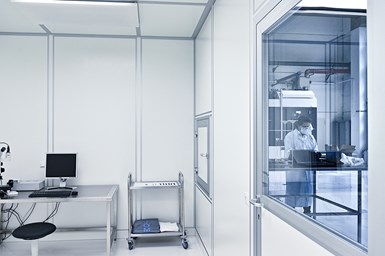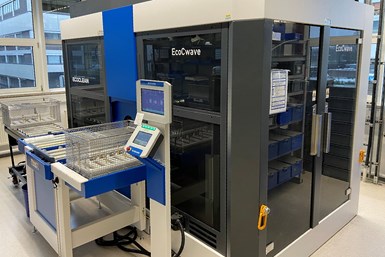Technology centers equipped with clean rooms and analysis equipment enable cleaning tests to be carried out and evaluated under clean conditions. Photo Credit: EcoClean
The SBS EcoClean Group (Southfield, Mich.) supplies companies with turnkey solutions and local services for the cleaning and packaging of medical products. These products range from simple plasters, syringes and cannulas to surgical instruments, implants and pacemakers, as well as large machines such as computer and magnetic resonance tomographs (CT and MRT).
With the European Medical Device Regulation (MDR) in force since the end of May 2021, as well as changing FDA requirements, regulations for cleaning and identifying parts for medical products — including new requirements for the qualification, documentation and traceability of the processes — have significantly increased. Under the new regulations, more products are covered and classified in a higher risk category. Particulate and filmic contaminations from manufacturing processes, as well as bioburden and cytotoxicity values, must now be considered. EcoClean says its range of certified cleaning solutions enable these requirements to be met in a robust and reproducible manner.
Featured Content
EcoClean’s cleaning and packaging systems are equipped with software solutions specially developed for medical technology applications and radio-frequency identification (RFID) technologies. This enables them to provide optimal conditions for equipment certification and process validation according to installation, operation and performance qualifications (IQ, OQ and PQ). According to the company, the inclusion of Audit-Trail and Code of Federal Regulations (CFR) 21 enables automatic acquisition and storage of process data and ensures that all parts and components processed in the systems can be seamlessly traced and identified.
Cleaning
New MDR and FDA regulations have to be met for cleaning medical components and products, including requirements for cleanliness, traceability, process validation and documentation. Photo Credit: Shutterstock / 123RF
A pre-cleaning step is necessary for particulates and thin-film residues that remain on the surfaces of components that are manufactured using machining, forming, extrusion and injection molding. For these tasks, EcoClean supplies modular and customized chamber cleaning systems which use solvents, such as modified alcohols or non-halogenated hydrocarbons, as well as aqueous media (neutral, acidic, alkaline). An intermediate cleaning step that is usually performed after finishing processes can be carried out in an aqueous chamber or in-line immersion cleaning system — for example, the UCMSmartLine.
EcoClean says that in human and dental medicine, additively manufactured components play an increasingly important role in individual patient care. Powder residues from parts produced in powder bed-based printing processes must be cleaned off after unpacking. Dry methods such as vacuum technology can be used to do this, which also enable excess powder to be recovered.
In addition, capillary, lumen or pore structures of geometrically complex components manufactured in sintering or 3D printing processes are especially difficult to clean. For these tasks, multi-stage immersion cleaning systems equipped with multi-frequency ultrasound, injection flood washing and/or pulsated pressure cleaning (PPC) are used, coupled with a suitable medium. According to EcoClean, this ensures that contaminants and powder residues are reliably removed from the most delicate structures, narrow lumens and complex geometries.
The final or ultra-fine cleaning of medical technology products usually takes place in a task-specific immersion cleaning system that can be integrated or connected to a cleanroom. Photo Credit: EcoClean / UCM
The final cleaning step is usually carried out in customized in-line immersion cleaning systems, with the appropriate water treatment and cleaning fluid. A passivation step can also be integrated here as necessary. A cleanroom-compatible design of the system or connection to a cleanroom, which is also planned by the EcoClean Group, is a further service that is available on request.
Packaging
Regardless of whether the products need sterile or non-sterile packaging after final cleaning, EcoClean’s solutions include suitably-adapted machines and equipment. EcoClean says that previously designed and validated packaging materials for medical instruments and implants can be used to ensure that production gets off to a quick start.
Global delivery and local service
EcoClean’s solutions for the medical industry include the planning, development and manufacture of cleaning systems, as well as interface coordination and implementation. When installing the equipment, local service staff trains customer employees to operate and maintain the systems, provides technical support during operation and also supplies any necessary spare parts. EcoClean claims that this guarantees maximum availability of the systems and machines.
RELATED CONTENT
-
Super Finishing: ‘Micro Machining Process’ Vital To Medical Industry
Using high-precision tools and technologies that smoothes a surface—or even intentionally leaves specific controlled amounts of roughness behind—MMP is unlike any treatment on the finishing market.
-
Automation Smoothes the Way for Surgical Coatings
Medical device coating company discusses how automation enables increased abrasion resistance and improved insulative properties for electrosurgery.
-
A Process for Alkaline Non-cyanide Silver Plating for Direct Plating on Copper, Copper Alloys and Nickel Without a Silver Strike Bath
Traditionally, silver is electroplated in toxic, cyanide-based chemistry. Due to cyanide’s extreme hazard to human health and environments, developing non-cyanide silver chemistry is essential for the silver electroplating industry. Discussed here is an aqueous, alkaline non-cyanide silver plating technology, which can be directly plated over nickel as well as copper and its alloys. The silver deposits have perfect white color and better anti-tarnishing properties than other non-cyanide silver processes. The silver is plated entirely from the dissolving silver anode and the bath is very stable, and maintains a stable pH level both during plating and idle time. This new non-cyanide silver technology will plate bright silver that is perfectly suitable for electronic, industrial and decorative applications. .
























